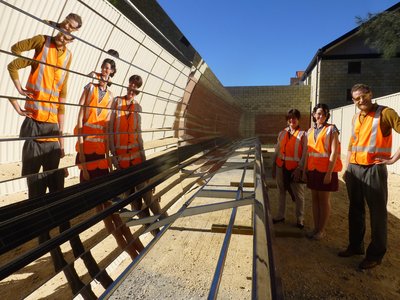Desalination in the desert
Researchers at Murdoch University are working with the National Centre of Excellence in Desalination Australia (NCEDA) on a project to secure water supplies in desert communities.
Led by Dr Trevor Pryor, Dr Tania Urmee and Research Associate Kane Low, the research team chose the Tjuntjuntjara community, 700 km east of Kalgoorlie, because it has an acute shortage of fresh water but abundant hypersaline groundwater, which is even saltier than seawater.
“The community’s only water supply is a small lens of subterranean fresh water that floats on the hypersaline water and easily depletes,” said NCEDA CEO Neil Palmer.
Palmer said the desalination process involves a German memsys membrane distillation system, capacity 20 L/h distilled water, coupled to a US Cogenra parabolic solar photovoltaic and heating system. NCEDA staff at Tjuntjuntjara are currently installing a 250 m pipeline from an existing hypersaline bore, and associated electrics and an enclosure to house the memsys system.

The solar-powered membrane distillation system uses less energy than traditional reverse osmosis desalination, provided that cheap heat is available. The sun-drenched desert location is thus particularly suitable for the pilot plant, which should ideally produce up to 1 kL of distilled water each day, said Palmer.
“These results will be used to determine an economic and technical case for scale-up to a 20 kL/day distilled water production system, which will double the current supply from the existing fresh groundwater lens,” he added.
The system has been designed to require less maintenance, with plans to encourage the local people to keep the pilot plant running smoothly. The hydrophobic membrane “doesn’t scale and can be cleaned by flushing with distilled water”, said Palmer.
The memsys system, currently based at NCEDA’s Rockingham Desalination Research Facility, will soon be dismantled and transported to Tjuntjuntjara for installation and testing, while the Cogenra solar system will be relocated in November.
Members of the Tjuntjuntjara community, part of a larger Indigenous group known as the Spinifex People, moved to the Great Victoria Desert in the 1950s, prior to the Maralinga atomic tests. The Tjuntjuntjara site was established in 1988 after an earlier temporary camp ran out of water.
“We are expecting this technology will provide enough potable water to allow the community to grow and develop sustainably,” Palmer said.
“If it works at Tjuntjuntjara, it’s likely it will work in other remote desert communities too.”
New membranes could help eliminate brine waste at desalination plants
Membranes packed with charge can help overcome the current salinity limit, making it easier to...
Balancing energy and water in data centres
World Water Day served as a timely reminder that we all have a role to play in tackling climate...
Greater Western Water uses Gorman-Rupp pump in water delivery project
The Gorman-Rupp pump was selected for Greater Western Water's WIN project to deliver...










